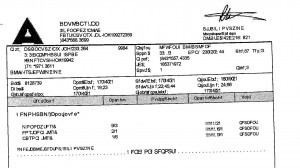Electronic Medical Records: How Useful Are They?
 Click on the image to enlarge. If you can tell me what it says, I will pat you on the back. Electronic medical records can confuse the analysis of a case.
Click on the image to enlarge. If you can tell me what it says, I will pat you on the back. Electronic medical records can confuse the analysis of a case.
Scenario: Mrs. Smith sustained multiple trauma including a severe brain injury after a fall. She was minimally responsive and had severe contractures of all her extremities seven months after her fall. She was totally dependent on the staff for her every need.
Unfortunately, Mrs. Smith’s rehab record was electronic. I say unfortunately, because the electronic nursing records contained hundreds of pages of very little helpful information. It was difficult to create a true picture of what Mrs. Smith endured.
She was severely contracted, yet that was barely mentioned throughout these records. Only one nursing entry mentioned “cervical dystonic posturing”. Examples of meaningless, almost nonsensical, entries, which were often repeated, included:
Nonsensical electronic medical records phrases
1) “ADLs Safety: Call device within reach” Just below this entry: “Demonstrates ability to use call light successfully: No”. (NOTE: Why put a call light within reach of a patient who cannot use it due to her cognitive limitations and contractures of her arms?
2) “Urinary Elimination: Voiding, no difficulties”. Just below this entry: “Voiding difficulties – Incontinence” (NOTE: How can she have no voiding difficulties in one entry, and have voiding difficulties in the next entry?!)
3) “Gait/transferring: Normal, bedrest, immobile” (NOTE: What does this mean? Are they saying she has a normal gait?)
4) “Mental Status: Forgets limitations” (NOTE: This woman was unaware of her limitations and could not communicate well enough to even tell the staff she forgot something.)
5) “Grooming: Patient does only 1 of 5 tasks or no tasks” (NOTE: Well, which is it? And by all other documentation available, I could see Mrs. Smith was unable to perform any tasks.)
6) “Environmental Safety Implemented: Encourage personal mobility support item use” (NOTE: This woman could not walk so this entry is nonsensical.)
7) “Environmental Safety Implemented: Personal items within reach” (NOTE: Don’t get me started again…)
I actually found myself getting angry reviewing these electronic medical records. Are nurses wasting valuable time away from patient care to enter useful information that comes out useless? Or is inputting useful information so difficult and time-consuming that there are many errors trying to input the data?
I got more out of brief, handwritten notes such as, “WDWN in NAD. VSS. OOB to chair.” At least I knew the person was well-developed, well nourished, in no apparent distress, her vital signs were stable, and she could get out of bed to a chair. And I could find this out by reading a short entry, rather than hundreds of pages of disjointed entries.
Am I saying there is no useful information in these electronic medical records? No. It’s just become much more difficult to find it.
It seems we have exchanged the problems of illegible records due to poor handwriting with unintelligible records due to computerization. Is it a good trade-off? What do you think?
This is the opposite of the GIGO (Garbage In, Garbage Out) principle. This is Good (info) In, Garbage Out. It seems that many of these electronic medical records programs focus on data entry, and not on information output. Or is the output deliberately unclear and difficult to follow?
It seems reasonable to me that if all this information is computerized, we should be able to request the format that it is printed in. For example, why can’t we ask for the records to be printed in chronological order, from the beginning of the history (oldest records) to the end (most recent)? When records are printed with the most recent information first, it is like trying to read a book backwards.
It seems that before this big push for electronic medical records continues, there should be tremendous attention placed on whether the information output is useful…and accurate. Having a medical record that shows entries such as those above for an unfortunate patient with severe functional and cognitive impairments is totally unhelpful.
Are you finding that medical records now take much more time and effort to review? Do you feel you are left with many more questions than answers?
Jane D. Heron, RN, BSN, MBA was employed as a legal nurse consultant at Med League, at the time she wrote this post. Pat Iyer established this independent LNC business in 1989 and sold it in 2015.
